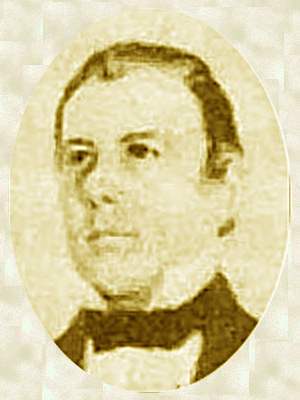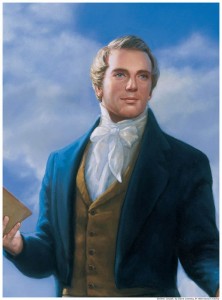Thomas B Marsh was, for a time, an apostle for The Church of Jesus Christ of Latter-day Saints, until his excommunication. He eventually returned to the church.
 Thomas B. Marsh was born in 1799 in Massachusetts, the son of James Marsh and Mary Law. In 1820, he married Elizabeth Godkin and began a grocery business. When it failed, he moved to Boston, where he worked in a type foundry for seven years.
Thomas B. Marsh was born in 1799 in Massachusetts, the son of James Marsh and Mary Law. In 1820, he married Elizabeth Godkin and began a grocery business. When it failed, he moved to Boston, where he worked in a type foundry for seven years.
While in Boston, he became a Methodist for a time, but soon decided the church’s teaching didn’t match what he read in the Bible. He ended his membership and felt the spirit tell him that in time, the true church would be restored. He then felt impressed to travel, where he eventually found himself in Palmyra. When he arrived at a printing shop, he met Martin Harris. The first sixteen pages of the Book of Mormon had just been printed and he read them. He believed the book to be true and asked permission to take a copy of those pages home with him to Massachusetts. He gave them to his wife, Elizabeth, who also read and believed them. However, the church had not yet been organized, so he could not act on this belief. He maintained contact with future church leaders and when he learned the church had been organized, he moved with his family to Palmyra, New York, where Joseph Smith lived. He was soon baptized and given the priesthood. He was the subject of a revelation given through Joseph Smith, in which he was praised for his faith and reassured his family would be cared for. He was given a calling (volunteer assignment) to preach the gospel and serve the church. He was appointed to be a physician to those beginning to gather together as new members of the Church.
In 1831, the Mormons moved to Kirtland, Ohio, in an attempt to find safety and the right to practice their religion in peace. Thomas B. March moved there with the Saints, as the Mormons called themselves. At a conference held there, he became a high priest and was soon called to serve a mission. He returned home early the next year. This was followed by a shorter mission to New York. He was then placed in charge of a small group of Mormons sent to settle on the Big Blue River in Jackson County, Missouri. They were soon driven from their homes by mobs and Thomas settled his family in Lafayette County, where he taught school. He then moved to Clay County and became a member of the high council, a local leadership organization in the Church.
In January of 1835, he returned to Kirtland, Ohio, and became an apostle. Since all the apostles were called at the same time, they were ordered by age instead of seniority as they are today. This made him the president of the apostles, since he was, at age 35, the oldest apostle.
Thomas B. Marsh developed a reputation as a problem solver. He was sent as part of a committee to help resolve conflicts between Clay County and Church members in the county. His speech to them was so powerful General Atchison was moved to tears.
 In 1837, Joseph delivered a revelation to Thomas Marsh for the apostles, encouraging them to be faithful and not to be rebellious. Some rebelliousness was already arising among this group of inexperienced leaders facing intense persecution and challenges. Some did not handle the persecution well and some thought there should be none if the Church was true.
In 1837, Joseph delivered a revelation to Thomas Marsh for the apostles, encouraging them to be faithful and not to be rebellious. Some rebelliousness was already arising among this group of inexperienced leaders facing intense persecution and challenges. Some did not handle the persecution well and some thought there should be none if the Church was true.
Problems arose in Far West, Missouri, and some church leaders lost their place in the church. Thomas B. Marsh and David Patten were sent to lead the Mormons there until Joseph Smith could arrive to call new leaders. Then he, Patten, and Brigham Young were made the local area presidency. The other two were sent to travel while David was instructed to stay and lead the people.
In October, Thomas’ faithful church service began to unravel because of a problem that began with his wife and cheese. Elizabeth and her friend, Sister Harris, earned money by selling homemade cheese. They decided they could make more money if they combined their milk and to further increase profits and keep things fair, they agreed to include the skimmings. The skimmings were richer in cream. Sister Harris included her skimmings, but Elizabeth did not. She kept a pint for herself so her personal cheese would be especially tasty. In this small community, disagreements were often settled at the community level, which was also the church level, so they asked their home teachers to decide their argument over this. They felt Elizabeth had been dishonest, and she and Thomas became extremely angry over this. The matter was then turned over to the bishop and the local church leaders to decide. They also agreed that she had made a contract with Sister Harris and had violated the contract. Still angry, the Marshes demanded the issue go even higher. The high council supported the decisions of the lower bodies, so Thomas demanded the prophet himself review the case. When the prophet agreed that Sister March had violated her business commitment, Marsh became so angry he went to a judge and swore an affidavit that the Mormons were hostile to the state. This was a desire to “get even” but it had tragic consequences. His affidavit became a factor in Governor Bogg’s decision to issue an extermination order against the Mormons, a decision that led to many deaths and persecutions.
In 1839, he was excommunicated for his role in causing the deaths of other church members. Nineteen years later, he came to Brigham Young, then president of the Church, and pleaded forgiveness. He wrote a letter to Heber C. Kimball, the First Counselor to the president of the Church and said, “The Lord could get along very well without me and He … lost nothing by my falling out of the ranks; But O what have I lost?! Riches, greater riches than all this world or many planets like this could afford.” (See Thomas S. Monson, School Thy Feelings, O My Brother, General Conference, October 2009.)
He was re-baptized and moved to Utah to live. One month after his arrival in Salt Lake Valley, he married Hannah Adams (4 October 1857). The couple soon settled in Spainish Fork, where they acquired a small adobe house. It was there that he attempted, without success, to establish a school. Though having received some financial help from Bishop John L. Butler, the Marshes were barely able to sustain life. By late fall of 1859, because of his circumstances, Marsh requested further assistance. His petition reflected his penitent spirit:
[I write] not in a spirit of complaining of any person neither of murmuring against the providence of my Heavenly Father; no! It is good enough for me for I have sin[n]ed and made many crooked paths and I would rather kiss the chastning hand and thank Him that it is as well with me as it is for He in his providence has brought me to the Valies of these mountains! fed and clothed me and kept me alive untill now, given me a name and place among his people and restored me, vile as I have been, [to] His Everlasting Priesthood, notwithstanding I so foolishly and so ignominiously once threw it away and cast it behind my back.
On 11 March 1859, Thomas B. Marsh was re-ordained an elder, and by November 1861 he had been ordained a high priest. On 1 November 1862, in the Endowment House, he received his endowment and was sealed to his wife, Hannah. At about the same time the couple made the decision to settle in Ogden. In Ogden, he was placed in the care of David M. Stuart, Ogden First Ward. He was supported almost totally by the Church until the time of his death in January 1866. The records show that Thomas Baldwin Marsh “died in good faith,” having once again embraced the principles he had espoused nearly thirty-six years earlier in Fayette, New York.
About Terrie Lynn Bittner
The late Terrie Lynn Bittner—beloved wife, mother, grandmother, and friend—was the author of two homeschooling books and numerous articles, including several that appeared in Latter-day Saint magazines. She became a member of the Church at the age of 17 and began sharing her faith online in 1992.

 Watch a video about the restoration of the gospel on lds.org
Watch a video about the restoration of the gospel on lds.org